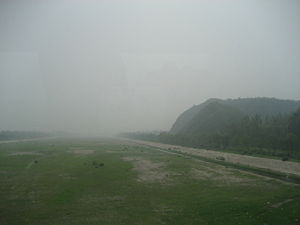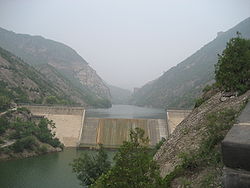
China water crisis
Encyclopedia

Water crisis
Water crisis is a general term used to describe a situation where the available water within a region is less than the region's demand. The term has been used to describe the availability of potable water in a variety of regions by the United Nations and other world organizations...
threatens the stability and prosperity not only in People's Republic of China
People's Republic of China
China , officially the People's Republic of China , is the most populous country in the world, with over 1.3 billion citizens. Located in East Asia, the country covers approximately 9.6 million square kilometres...
but globally as well, according to John McAlister from the film Aquabiotronics. According to the World Bank
World Bank
The World Bank is an international financial institution that provides loans to developing countries for capital programmes.The World Bank's official goal is the reduction of poverty...
forecast, Mainland China
Mainland China
Mainland China, the Chinese mainland or simply the mainland, is a geopolitical term that refers to the area under the jurisdiction of the People's Republic of China . According to the Taipei-based Mainland Affairs Council, the term excludes the PRC Special Administrative Regions of Hong Kong and...
has only a per-capita share of 2700 cubic meters per annum, one quarter of the world's average. Half of China's 617 largest cities face water deficits. Beijing
Beijing
Beijing , also known as Peking , is the capital of the People's Republic of China and one of the most populous cities in the world, with a population of 19,612,368 as of 2010. The city is the country's political, cultural, and educational center, and home to the headquarters for most of China's...
is among the cities which will be most affected. Northern China is now relying on 10,000-year-old aquifers to meet the demand of China's large population, which has resulted in ground cracking and subsidence in some regions.
Regional disparity
The areas south of the Yangtze RiverYangtze River
The Yangtze, Yangzi or Cháng Jiāng is the longest river in Asia, and the third-longest in the world. It flows for from the glaciers on the Tibetan Plateau in Qinghai eastward across southwest, central and eastern China before emptying into the East China Sea at Shanghai. It is also one of the...
, China's longest, which account for only 36.5 per cent of the country's total territory, have 80.9 per cent of its total water resources. However the areas north of the Yangtze, which make up 63.5 per cent of China, possess only 19.1 per cent of total water resources.
Taihu Blue Algae Bloom
In the summer of 2007 a thick toxic blanket of blue-green algae covered Lake Tai in JiangsuJiangsu
' is a province of the People's Republic of China, located along the east coast of the country. The name comes from jiang, short for the city of Jiangning , and su, for the city of Suzhou. The abbreviation for this province is "苏" , the second character of its name...
province. Chemical fertilizers were identified as one of the main causes.
Greenpeace China
Greenpeace China
Greenpeace East Asia is an office serving the East Asia region of the global environmental organization Greenpeace. It is one of the largest international NGOs in China.-History:Greenpeace East Asia's first China office was opened in Hong Kong in 1997...
tested the water in 2008. Of the 25 water samples examined, 20 of them had such high concentrations of nitrogen
Nitrogen
Nitrogen is a chemical element that has the symbol N, atomic number of 7 and atomic mass 14.00674 u. Elemental nitrogen is a colorless, odorless, tasteless, and mostly inert diatomic gas at standard conditions, constituting 78.08% by volume of Earth's atmosphere...
and nitrates that they were not safe for human use. They were even too polluted to be used to water plants or in factories.
Activism in north China
Leading Chinese environmental activist and journalist Ma JunMa Jun (environmentalist)
Ma Jun is a Chinese environmentalist, non-fiction writer, environmental consultant, and journalist. He is a director with the Institute of Public & Environmental Affairs ....
has warned that China is facing a water crisis
Water crisis
Water crisis is a general term used to describe a situation where the available water within a region is less than the region's demand. The term has been used to describe the availability of potable water in a variety of regions by the United Nations and other world organizations...
that includes water shortages, water pollution and a deterioration in water quality. 400 out of 600 cities in China are facing water shortages to varying degrees, including 30 out of the 32 largest cities. Discharges of waste water have increased continually over the years 2001-2006, and Ma's statistics show that 300 million peasant
Peasant
A peasant is an agricultural worker who generally tend to be poor and homeless-Etymology:The word is derived from 15th century French païsant meaning one from the pays, or countryside, ultimately from the Latin pagus, or outlying administrative district.- Position in society :Peasants typically...
s’ drinking water is not safe.
He has warned: "In the north, due to the drying up of the surface water, the underground water has been over-extracted. The water shortage in the north could have drastic affects because almost half of China’s population lives on only 15 percent of its water. The situation is not sustainable. Though the south has abundant water, there is a lack of clean water due to serious water pollution. Even water-abundant deltas like the Yangtze and the Pearl River
Pearl River (China)
The Pearl River or less commonly, the "Guangdong River" or "Canton River" etc., , is an extensive river system in southern China. The name Pearl River is usually used as a catchment term to refer to the watersheds of the Xi Jiang , the Bei Jiang , and the Dong Jiang...
suffer from water shortages."
In 2004 the World Bank
World Bank
The World Bank is an international financial institution that provides loans to developing countries for capital programmes.The World Bank's official goal is the reduction of poverty...
warned that the scarcity of the resource would lead to "a fight between rural interests, urban interests and industrial interests on who gets water in China." The validity of this prediction was confirmed, for example, in April 2005 when many people were injured in Dongyang
Dongyang
Dongyang is a Chinese city of about 800,000 people in the middle of Zhejiang Province, about 200 kilometers south of Hangzhou. Dongyang lies in the central area of Zhejiang Province, covering an area of 1739 square kilometers...
city, Zhejiang Province, in clashes over the nearby chemical factories of the Juxi Industrial Park accused of water pollution
Water pollution
Water pollution is the contamination of water bodies . Water pollution occurs when pollutants are discharged directly or indirectly into water bodies without adequate treatment to remove harmful compounds....
that harmed crops and led to deformed babies being born.

World Bank forecasts
If present trends are not reversed, the World Bank forecasts that by 2020 there will be 30 million environmental refugees in China due to water stress.- With 20% of the world’s population but only 7% of global water resources, China meets with a severe challenge.
- More than half of China’s 660 cities suffer from water shortages, affecting 160 million people.
- The per capita water volume in China is one fourth of the world average.
- 90% of cities’ groundwater and 75% of riverRiverA river is a natural watercourse, usually freshwater, flowing towards an ocean, a lake, a sea, or another river. In a few cases, a river simply flows into the ground or dries up completely before reaching another body of water. Small rivers may also be called by several other names, including...
s and lakeLakeA lake is a body of relatively still fresh or salt water of considerable size, localized in a basin, that is surrounded by land. Lakes are inland and not part of the ocean and therefore are distinct from lagoons, and are larger and deeper than ponds. Lakes can be contrasted with rivers or streams,...
s are polluted. - As a result of widespread water pollution, 700 million people drink contaminated water every day.
- Waterborne diseases have created a rising number of premature deaths.
- Between November 2005 and January 2006, three large-scale incidents occurred, halting water supplyDrinking waterDrinking water or potable water is water pure enough to be consumed or used with low risk of immediate or long term harm. In most developed countries, the water supplied to households, commerce and industry is all of drinking water standard, even though only a very small proportion is actually...
for millions of people and raising awareness of the challenges ahead. - The government plans to mitigate water pollutionWater pollutionWater pollution is the contamination of water bodies . Water pollution occurs when pollutants are discharged directly or indirectly into water bodies without adequate treatment to remove harmful compounds....
by investing in wastewater treatmentWastewater TreatmentWastewater treatment may refer to:* Sewage treatment* Industrial wastewater treatment...
facilities.
Films
- Shifting Nature. Produced by BBC Two.
See also
- Water resources of ChinaWater resources of ChinaThe water resources of China are abundant on average, but are scarce in some regions. About 80% of all water resources are in one river basin, the Yangtze. Water is scarce around Beijing, where groundwater is overexploited. Agriculture is the major water user accounting for 78% of water use...
- Water supply and sanitation in the People's Republic of ChinaWater supply and sanitation in the People's Republic of ChinaWater supply and sanitation in China is undergoing a massive transition while facing numerous challenges such as rapid urbanization, a widening gap between rich and poor as well as urban and rural areas...
- Deficit irrigationDeficit irrigationDeficit irrigation is a watering strategy that can be applied by different types of irrigation application methods. The correct application of DI requires thorough understanding of the yield response to water and of the economic impact of reductions in harvest...
External links
- chinadialogue 中国与世界,环境危机大家谈 - bilingual news and in-depth articles on China's environmental crisis
- China's Water Management An interview of Joël Cicéron, director of Veolia Water in Taiwan.
- River Pollution in China Photo essay on water pollution in the Huai River Basin
- Worsening Water Shortages Threaten China's Food Security
- Water issues in China, from PBS site
- China water pollution - Greenpeace China
- CNN.com audio slideshow on water pollution in China

